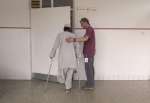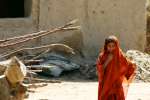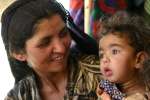- Text size
 |
|  |
|  |
| 
- Français
Refugees face long cold and wet night at crowded Balkan border crossings
News Stories, 21 October 2015
BERKASOVO, Serbia, Oct 21, (UNHCR) – It is 6 pm, and night is falling fast. Amr and his family huddle under a makeshift shelter, partially lit by a nearby fire, on a small hill near the Serbian-Croatian border.
It is windy and cold -- the temperature having fallen to around 7 degrees.
Amr and his family were among nearly 2,000 refugees and migrants stuck at the border overnight Tuesday (October 19) amid growing backlogs and administrative delays. They had been waiting since midday.
No-one knew when they would be able to cross, so they prepared to spend the night on a muddy field in the no man's land between Serbia and Croatia. People shivered, children cried, their clothes wet and dirty from days of travel.
Amr and his cousin made a shelter for the women and the children with what little they could find. "We made it with what we found. The roof is a sleeping bag. It's too dangerous for the kids here. It is cold," Amr added.
Strict border management procedures are in place and refugees are not allowed to cross for a certain time in order to avoid overcrowding and to wait until transit centres again have capacity to receive more refugees.
Between midnight and 4 am, movement accelerated again and about 450 people crossed over, then it stalled. Meantime, the swell of people on the Serbian side quickly grew to 3,500.
To help refugees cope with trying circumstances, particularly the young, UNHCR distributed 460 blankets, 1,000 energy bars and 260 bottles of water, but it is still a miserable wait and dangerous for the very young.
Amr, 33, fled Damascus a few weeks ago with his widowed sister, her two kids, two cousins and a friend. His sister's husband was killed by a missile.
The group decided to head to safety in Europe, but were not sure where exactly. They know only they want to be safe, but the road is difficult. Sometimes it is hard to keep smiling.
"In Syria, it is not two parties fighting, it is many. They don't know why they kill each other. How would I know why they kill people? It will not finish in one or two years. It will take long. I can't live there with my family," Amr said.
"My brother in law died because of a missile. The building collapsed. His wife and children were not in the house".
More than 643,000 refugees and migrants arrived in Europe via the Mediterranean Sea this year, including 502,500 in Greece only. Many of the refugees and migrants are desperate to move quickly onwards to Western Europe, fearing that borders ahead of them will close.
To address this current situation, UNHCR has called for a series of stabilization measures, including strong support to countries hosting the vast majority of Syrian, Iraqi and Afghan refugees, an information campaign informing of the dangers of the sea journey, and the development of legal pathways to seek protection in Europe.
On Tuesday morning (October 19), there were more than 27,500 people on the Aegean Islands, either awaiting registration or onward transport to the mainland, and 5,000 new arrivals were recorded every day.
Next to Amr's group, eight young Afghans, including some under 18, light a fire with a toothpaste carton, wood and what little else they can find. By now, it is really dark and the temperatures drop even further.
"There is war since 20 years in our country. What should we do?" one, Saber, 15, asked.
Meanwhile, a UNHCR refugee protection officer from Croatia walks through the crowd to identify vulnerable people who need immediate assistance. She spots Mohamed, his wife Fatima and their two babies.
"It's going to be too long for them. Some 500 people are on the road in Croatia just ahead of the border. 1,000 more are walking toward Opatovac reception centre and more than 2,000 are in the reception centre. The buses can't even drive on the road," Diana Difor said.
Celine Schmitt, Berkasovo, Serbia
















































